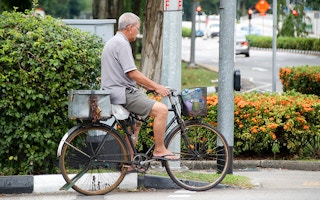What does your mind conjure up when you see the word ‘cyclist’? The Tour de France and Lycra? Or a father cycling his children to school? A woman in a suit en route to work? A man on a cargo bike selling fruits down the street?
Visions of cycling depend significantly on time and place. In the developed world, cycling is commonly recognised as a mode of recreation and, increasingly, of transportation. Depending on the country, cyclists’ are merely tolerated, pushed to the fringes and ignored — or worse, not seen at all. In others, kings, queens and prime ministers cycle to work, and no one thinks twice about it.
In the developing world, cycling can be commonplace but viewed as a “poor man’s” transportation — and often made inaccessible to women. Beijing used to have one of the highest percentages of cyclists in the world, but these numbers have declined steadily since the 1980s. Copenhagen is now touted as having the highest cycling levels, but many cities are close behind — when the data exist, anyways.
But whether numbers are going up, down or sideways, the overall trend is toward increasing interest in cycling in all its forms and from all levels of government. In part this is because of what cycling can achieve — and already has achieved.
For many of the same reasons, cycling is a key tool for achieving the implementation of the goals of the New Urban Agenda, the new global urbanisation strategy that is set to be adopted at the Habitat III conference this month in Quito, Ecuador.
Shifting gears
The New Urban Agenda shows a clear paradigm shift, one that sees urbanisation as people-centred and a transformative force.
Previously, urbanisation was seen as something to be contained or managed in a way that lessens its negative impacts, not something from which growth and innovation can occur. Over the years, this has been proven false, and the New Urban Agenda is a culmination of this shift in gears.
Today, with urban populations growing every day, urbanisation is inevitable. And while several months of negotiations removed or watered down some of the more key changes in the text, overall the agenda retains a sense of harnessing the power of cities and citizens for growth, innovation, sustainability and community-building.
The same holds true for mobility in cities. Previous decades of urbanisation made paving roads an indicator of success and development. Entire residential neighbours were knocked down for highways and parking space. Due to those previous choices, the built environment in most cities today still largely revolve around motorised vehicles — a policy decision that overlooks the actual inhabitants of the city.
Through the New Urban Agenda — focused on people, sustainability, accessibility — cities become less about cars, buses and bicycles, but rather about drivers, passengers and cyclists. By placing people at the centre, policies and the urban environment would revolve around them. At least, that’s the idea.
Recent decades have put increased pressure on anything city-related: housing, services, space and mobility. With more people needing to get from place to place, mobility becomes a defining feature of accessible and liveable cities. You can live in a great, inclusive housing complex, but if you cannot get to work or school or the store in a timely and cost-effective manner, you have a problem.
Furthermore, congestion, air quality, sedentary lifestyles are all linked to variants of our current transportation models. Car-centred cities forget the people that are supposed to live (and move) in them safely and healthfully.
Cycling and active mobility therefore need to play key roles, and not just as part of the transport sector. Ultimately, a paradigm shift means rethinking mobility as shared space and connectivity — roads, sidewalks and bicycle paths are public spaces and meeting points, not just arteries for movement. The New Urban Agenda does just that.
And in this, the agenda is strikingly unique. The outcome strategies from the previous two Habitat conferences — in 1976 and 1996 — each mention cycling just a single time. This time around? Cycling is mentioned five times explicitly, and in a variety of ways.
Finally, human scale
The text of the final draft New Urban Agenda was agreed in early September, and it is expected that the document will be adopted in Quito with few changes.
Over the course of four months of negotiations, U. N. member states ended up with a document that makes a strong connection between health and cycling. It explicitly links active mobility, preventative health care and the reduction of non-communicable diseases and injuries (Paragraph 113). Elsewhere, it states that national governments “will support the provision of well-designed networks of safe, inclusive for all inhabitants, accessible, green, and quality public spaces and streets […] promoting walkability and cycling towards improving health and well-being” (Paragraph 100).
This story was published with permission from Citiscope, a nonprofit news outlet that covers innovations in cities around the world. More at Citiscope.org.










